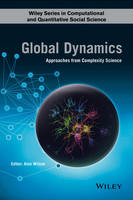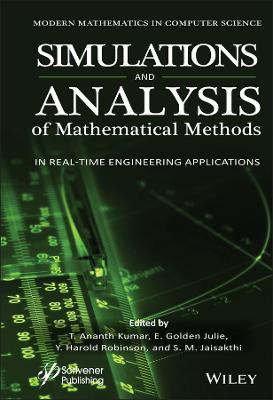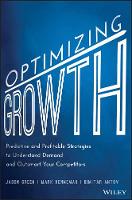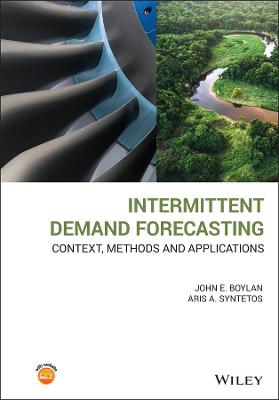Global Dynamics
 -15%
portes grátis
-15%
portes grátis
Global Dynamics
Approaches from Complexity Science
Wilson, Alan G.
John Wiley & Sons Inc
07/2016
352
Dura
Inglês
9781118922286
15 a 20 dias
822
Acknowledgements xvii
Part I GLOBAL DYNAMICS AND THE TOOLS OF COMPLEXITY SCIENCE
1 Global Dynamics and the Tools of Complexity Science 3
Alan Wilson
Reference 7
Part II TRADE AND ECONOMIC DEVELOPMENT
2 The Global Trade System and Its Evolution 11
Simone Caschili and Francesca Medda
2.1 The Evolution of the Shipping and Ports' System 11
2.2 Analyses of the Cargo Ship Network 12
2.3 A Complex Adaptive Systems (CASs) Perspective 15
2.4 Conclusions: The Benefits of a Systems Perspective 20
References 21
Appendix 23
A.1 Complexity Science and Complex Adaptive Systems: Key Characteristics 23
A.1.1 Four Properties 24
A.1.2 Three Mechanisms 25
3 An Interdependent Multi-layer Model for Trade 26
Simone Caschili, Francesca Medda, and Alan Wilson
3.1 Introduction 26
3.2 The Interdependent Multi-layer Model: Vertical Integration 27
3.3 Model Layers 30
3.3.1 Economic Layer 30
3.3.2 Social and Cultural Layer (Socio-cultural) 33
3.3.3 Physical Layer 34
3.4 The Workings of the Model 34
3.5 Model Calibration 35
3.6 Result 1: Steady State 39
3.7 Result 2: Estimation and Propagation of Shocks in the IMM 42
3.8 Discussion and Conclusions 48
References 48
4 A Global Inter-country Economic Model Based on Linked Input-Output Models 51
Robert G. Levy, Thomas P. Oleron Evans, and Alan Wilson
4.1 Introduction 51
4.2 Existing Global Economic Models 52
4.3 Description of the Model 53
4.3.1 Outline 53
4.3.2 Introduction to Input-Output Tables 53
4.3.3 A Single Country Model 55
4.3.4 An International Trade Model 57
4.3.5 Setting Model Coefficients from Data 58
4.4 Solving the Model 58
4.4.1 The Leontief Equation 58
4.4.2 The Drawbacks of Mathematical Elegance 59
4.4.3 Algorithm for an Iterative Solution 59
4.5 Analysis 61
4.5.1 Introduction 61
4.5.2 Simple Modelling Approaches 61
4.5.3 A Unified Network Approach 64
4.5.4 Comparison with a Multi-region Input-Output Model 67
4.6 Conclusions 67
Acknowledgements 69
References 69
Appendix 71
A.1 Modelling the 'Rest of the World' 71
A.2 Services Trade Data 71
A.2.1 Importing Own Exports 72
A.2.2 The Rest of the World for Sectors 72
Part III MIGRATION
5 Global Migration Modelling: A Review of Key Policy Needs and Research Centres 75
Adam Dennett and Pablo Mateos
5.1 Introduction 75
5.2 Policy and Migration Research 76
5.2.1 Key Policy Issues in Contemporary Migration Research 76
5.2.2 Linking Policy Issues to Modelling Challenges 81
5.2.3 Policy-related Research Questions for Modellers 82
5.2.4 Other International Migration Modelling Research 83
5.3 Conclusion 84
References 84
Appendix 87
A.1 United Kingdom 87
A.2 Rest of Europe 90
A.3 Rest of the World 94
6 Estimating Inter-regional Migration in Europe 97
Adam Dennett and Alan Wilson
6.1 Introduction 97
6.2 The Spatial System and the Modelling Challenge 98
6.3 Biproportional Fitting Modelling Methodology 100
6.3.1 Model (i) 104
6.3.2 Model (ii) 105
6.3.3 Model (iii) 105
6.3.4 Model (iv) 108
6.3.5 Model (v) 109
6.3.6 Model (vi) 110
6.4 Model Parameter Calibration 110
6.5 Model Experiments 113
6.6 Results 118
6.7 Conclusions and Comments on the New Framework for Estimating Inter-regional, Inter-country Migration Flows in Europe 121
References 123
7 Estimating an Annual Time Series of Global Migration Flows - An Alternative Methodology for Using Migrant Stock Data 125
Adam Dennett
7.1 Introduction 125
7.2 Methodology 129
7.2.1 Introduction 129
7.2.2 Calculating Migration Probabilities 129
7.2.3 Calculating Total Migrants in the Global System 130
7.2.4 Generating a Consistent Time Series of Migration Probabilities 133
7.2.5 Producing Annual Bilateral Estimates 135
7.3 Results and Validation 135
7.3.1 Introduction 135
7.3.2 IMEM comparison 135
7.3.3 UN Flow Data Comparison 136
7.4 Discussion 138
7.5 Conclusions 140
References 140
Part IV SECURITY
8 Conflict Modelling: Spatial Interaction as Threat 145
Peter Baudains and Alan Wilson
8.1 Introduction 145
8.2 Conflict Intensity: Space-Time Patterning of Events 146
8.3 Understanding Conflict Onset: Simulation-based Models 148
8.4 Forecasting Global Conflict Hotspots 150
8.5 A Spatial Model of Threat 150
8.6 Discussion: The Use of a Spatial Threat Measure in Models of Conflict 153
8.6.1 Threat in Models for Operational Decision-Making 153
8.6.2 Threat in a Model of Conflict Escalation 154
8.6.3 Threat in Modelling Global Military Expenditure 156
8.6.4 Summary 156
References 157
9 Riots 159
Peter Baudains
9.1 Introduction 159
9.2 The 2011 Riots in London 160
9.2.1 Space-Time Interaction 162
9.2.2 Journey to Crime 164
9.2.3 Characteristics of Rioters 165
9.3 Data-Driven Modelling of Riot Diffusion 166
9.4 Statistical Modelling of Target Choice 169
9.5 A Generative Model of the Riots 171
9.6 Discussion 172
References 173
10 Rebellions 175
Peter Baudains, Jyoti Belur, Alex Braithwaite, Elio Marchione and Shane D. Johnson
10.1 Introduction 175
10.2 Data 176
10.3 Hawkes model 177
10.4 Results 181
10.5 Discussion 183
References 185
11 Spatial Interaction as Threat: Modelling Maritime Piracy 187
Elio Marchione and Alan Wilson
11.1 The Model 187
11.2 The Test Case 188
11.3 Uses of the Model 189
Reference 191
Appendix 192
A.1 Volume Field of Type k Ship 192
A.2 Volume Field of Naval Units 193
A.3 Pirates Ports and Mother Ships 193
12 Space-Time Modelling of Insurgency and Counterinsurgency in Iraq 195
Alex Braithwaite and Shane Johnson
12.1 Introduction 195
12.2 Counterinsurgency in Iraq 196
12.3 Counterinsurgency Data 200
12.4 Diagnoses of Space, Time and Space-Time Distributions 202
12.4.1 Introduction 202
12.4.2 Spatial Distribution 202
12.4.3 Temporal Distribution 203
12.4.4 Space-Time Distribution 203
12.4.5 Univariate Knox Analysis 206
12.4.6 Bivariate Knox Analysis 208
12.5 Concluding Comments 210
References 212
13 International Information Flows, Government Response and the Contagion of Ethnic Conflict 214
Janina Beiser
13.1 Introduction 214
13.2 Global Information Flows 216
13.3 The Effect of Information Flows on Armed Civil Conflict 220
13.4 The Effect of Information Flows on Government Repression 225
13.5 Conclusion 226
References 226
Appendix 229
Part V AID AND DEVELOPMENT
14 International Development Aid: A Complex System 233
Belinda Wu
14.1 Introduction: A Complex Systems' Perspective 233
14.2 The International Development Aid System: Definitions 234
14.3 Features of International Development Aid as a Complex System 235
14.3.1 Introduction 235
14.3.2 Non-linearity 235
14.3.3 Connectedness 237
14.3.4 Self-Adapting and Self-Organising 238
14.3.5 Emergence 238
14.4 Complexity and Approaches to Research 238
14.4.1 Organisations 238
14.4.2 The Range of Issues 239
14.4.3 Research Approaches 240
14.4.4 The Complexity Science Approach 242
14.5 The Assessment of the Effectiveness of International Development Aid 242
14.5.1 Whether Aid Can Be Effective 242
14.5.2 Complexity in the Measurement of Aid Effectiveness 244
14.5.3 Complexity in Methods/Standards of Measurement of Aid Effectiveness 245
14.5.4 Standardising Aid Effectiveness 246
14.6 Relationships and Interactions 248
14.6.1 Relationships between Donor and Recipient Countries 248
14.6.2 Relationships between Aid and Other Systems 249
14.7 Conclusions 251
References 252
15 Model Building for the Complex System of International Development Aid 257
Belinda Wu, Sean Hanna and Alan Wilson
15.1 Introduction 257
15.2 Data Collection 258
15.2.1 Introduction 258
15.2.2 Aid Data 258
15.2.3 Trade Data 260
15.2.4 Security Data 261
15.2.5 Migration Data 261
15.2.6 Geographical Data 261
15.2.7 Data Selected 262
15.3 Model Building 263
15.3.1 Modelling Approach 263
15.3.2 Alesina and Dollar Model 263
15.3.3 Our Models 264
15.3.4 Model B: Introducing Donor Interactions and Modification of the Model 267
15.3.5 Findings from Model B 267
15.3.6 Model C: Introducing Interactions with Trade System and Further Modification of the Model 267
15.3.7 Findings from Model C 268
15.4 Discussion and Future Work 268
References 269
16 Aid Allocation: A Complex Perspective 271
Robert J. Downes and Steven R. Bishop
16.1 Aid Allocation Networks 271
16.1.1 Introduction 271
16.1.2 Why Networks? 272
16.1.3 Donor Motivation in Aid Allocation 273
16.2 Quantifying Aid via a Mathematical Model 273
16.2.1 Overview of Approach 273
16.2.2 Basic Set-Up 274
16.2.3 The Network of Nations 275
16.2.4 Preference Functions 275
16.2.5 Specifying the Preference Functions 275
16.2.6 Recipient Selection by Donors 276
16.3 Application of the Model 277
16.3.1 Introduction 277
16.3.2 Scenario 1. No Feedback 277
16.3.3 Scenario 2. Bandwagon Feedback 281
16.3.4 Scenario 3. Aid Effectiveness Feedback 283
16.3.5 Aid Usage Mechanism 284
16.3.6 Application 286
16.3.7 Conclusions 287
16.4 Remarks 287
Acknowledgements 288
References 288
Appendix 290
A.1 Common Functional Definitions 290
Part VI GLOBAL DYNAMICS: AN INTEGRATED MODEL AND POLICY CHALLENGES
17 An Integrated Model 293
Robert G. Levy
17.1 Introduction 293
17.2 Adding Migration 294
17.2.1 Introduction 294
17.2.2 The Familiarity Effect 295
17.2.3 Consumption Similarity 301
17.2.4 Conclusions 304
17.3 Adding Aid 304
17.3.1 Introduction 304
17.3.2 Estimating 'Exportness' 305
17.3.3 Modelling Approach 306
17.3.4 Results 306
17.3.5 Conclusions 314
17.4 Adding Security 316
17.4.1 Introduction 316
17.4.2 Literature Review 316
17.4.3 Measures of Threat and the Global Dynamics Model 317
17.4.4 Trade during Changing Security Conditions 318
17.4.5 An Experiment of Increased Threat in the Global Dynamics Model 318
17.4.6 Conclusions 322
17.5 Concluding Comments 323
References 324
Index 327
Acknowledgements xvii
Part I GLOBAL DYNAMICS AND THE TOOLS OF COMPLEXITY SCIENCE
1 Global Dynamics and the Tools of Complexity Science 3
Alan Wilson
Reference 7
Part II TRADE AND ECONOMIC DEVELOPMENT
2 The Global Trade System and Its Evolution 11
Simone Caschili and Francesca Medda
2.1 The Evolution of the Shipping and Ports' System 11
2.2 Analyses of the Cargo Ship Network 12
2.3 A Complex Adaptive Systems (CASs) Perspective 15
2.4 Conclusions: The Benefits of a Systems Perspective 20
References 21
Appendix 23
A.1 Complexity Science and Complex Adaptive Systems: Key Characteristics 23
A.1.1 Four Properties 24
A.1.2 Three Mechanisms 25
3 An Interdependent Multi-layer Model for Trade 26
Simone Caschili, Francesca Medda, and Alan Wilson
3.1 Introduction 26
3.2 The Interdependent Multi-layer Model: Vertical Integration 27
3.3 Model Layers 30
3.3.1 Economic Layer 30
3.3.2 Social and Cultural Layer (Socio-cultural) 33
3.3.3 Physical Layer 34
3.4 The Workings of the Model 34
3.5 Model Calibration 35
3.6 Result 1: Steady State 39
3.7 Result 2: Estimation and Propagation of Shocks in the IMM 42
3.8 Discussion and Conclusions 48
References 48
4 A Global Inter-country Economic Model Based on Linked Input-Output Models 51
Robert G. Levy, Thomas P. Oleron Evans, and Alan Wilson
4.1 Introduction 51
4.2 Existing Global Economic Models 52
4.3 Description of the Model 53
4.3.1 Outline 53
4.3.2 Introduction to Input-Output Tables 53
4.3.3 A Single Country Model 55
4.3.4 An International Trade Model 57
4.3.5 Setting Model Coefficients from Data 58
4.4 Solving the Model 58
4.4.1 The Leontief Equation 58
4.4.2 The Drawbacks of Mathematical Elegance 59
4.4.3 Algorithm for an Iterative Solution 59
4.5 Analysis 61
4.5.1 Introduction 61
4.5.2 Simple Modelling Approaches 61
4.5.3 A Unified Network Approach 64
4.5.4 Comparison with a Multi-region Input-Output Model 67
4.6 Conclusions 67
Acknowledgements 69
References 69
Appendix 71
A.1 Modelling the 'Rest of the World' 71
A.2 Services Trade Data 71
A.2.1 Importing Own Exports 72
A.2.2 The Rest of the World for Sectors 72
Part III MIGRATION
5 Global Migration Modelling: A Review of Key Policy Needs and Research Centres 75
Adam Dennett and Pablo Mateos
5.1 Introduction 75
5.2 Policy and Migration Research 76
5.2.1 Key Policy Issues in Contemporary Migration Research 76
5.2.2 Linking Policy Issues to Modelling Challenges 81
5.2.3 Policy-related Research Questions for Modellers 82
5.2.4 Other International Migration Modelling Research 83
5.3 Conclusion 84
References 84
Appendix 87
A.1 United Kingdom 87
A.2 Rest of Europe 90
A.3 Rest of the World 94
6 Estimating Inter-regional Migration in Europe 97
Adam Dennett and Alan Wilson
6.1 Introduction 97
6.2 The Spatial System and the Modelling Challenge 98
6.3 Biproportional Fitting Modelling Methodology 100
6.3.1 Model (i) 104
6.3.2 Model (ii) 105
6.3.3 Model (iii) 105
6.3.4 Model (iv) 108
6.3.5 Model (v) 109
6.3.6 Model (vi) 110
6.4 Model Parameter Calibration 110
6.5 Model Experiments 113
6.6 Results 118
6.7 Conclusions and Comments on the New Framework for Estimating Inter-regional, Inter-country Migration Flows in Europe 121
References 123
7 Estimating an Annual Time Series of Global Migration Flows - An Alternative Methodology for Using Migrant Stock Data 125
Adam Dennett
7.1 Introduction 125
7.2 Methodology 129
7.2.1 Introduction 129
7.2.2 Calculating Migration Probabilities 129
7.2.3 Calculating Total Migrants in the Global System 130
7.2.4 Generating a Consistent Time Series of Migration Probabilities 133
7.2.5 Producing Annual Bilateral Estimates 135
7.3 Results and Validation 135
7.3.1 Introduction 135
7.3.2 IMEM comparison 135
7.3.3 UN Flow Data Comparison 136
7.4 Discussion 138
7.5 Conclusions 140
References 140
Part IV SECURITY
8 Conflict Modelling: Spatial Interaction as Threat 145
Peter Baudains and Alan Wilson
8.1 Introduction 145
8.2 Conflict Intensity: Space-Time Patterning of Events 146
8.3 Understanding Conflict Onset: Simulation-based Models 148
8.4 Forecasting Global Conflict Hotspots 150
8.5 A Spatial Model of Threat 150
8.6 Discussion: The Use of a Spatial Threat Measure in Models of Conflict 153
8.6.1 Threat in Models for Operational Decision-Making 153
8.6.2 Threat in a Model of Conflict Escalation 154
8.6.3 Threat in Modelling Global Military Expenditure 156
8.6.4 Summary 156
References 157
9 Riots 159
Peter Baudains
9.1 Introduction 159
9.2 The 2011 Riots in London 160
9.2.1 Space-Time Interaction 162
9.2.2 Journey to Crime 164
9.2.3 Characteristics of Rioters 165
9.3 Data-Driven Modelling of Riot Diffusion 166
9.4 Statistical Modelling of Target Choice 169
9.5 A Generative Model of the Riots 171
9.6 Discussion 172
References 173
10 Rebellions 175
Peter Baudains, Jyoti Belur, Alex Braithwaite, Elio Marchione and Shane D. Johnson
10.1 Introduction 175
10.2 Data 176
10.3 Hawkes model 177
10.4 Results 181
10.5 Discussion 183
References 185
11 Spatial Interaction as Threat: Modelling Maritime Piracy 187
Elio Marchione and Alan Wilson
11.1 The Model 187
11.2 The Test Case 188
11.3 Uses of the Model 189
Reference 191
Appendix 192
A.1 Volume Field of Type k Ship 192
A.2 Volume Field of Naval Units 193
A.3 Pirates Ports and Mother Ships 193
12 Space-Time Modelling of Insurgency and Counterinsurgency in Iraq 195
Alex Braithwaite and Shane Johnson
12.1 Introduction 195
12.2 Counterinsurgency in Iraq 196
12.3 Counterinsurgency Data 200
12.4 Diagnoses of Space, Time and Space-Time Distributions 202
12.4.1 Introduction 202
12.4.2 Spatial Distribution 202
12.4.3 Temporal Distribution 203
12.4.4 Space-Time Distribution 203
12.4.5 Univariate Knox Analysis 206
12.4.6 Bivariate Knox Analysis 208
12.5 Concluding Comments 210
References 212
13 International Information Flows, Government Response and the Contagion of Ethnic Conflict 214
Janina Beiser
13.1 Introduction 214
13.2 Global Information Flows 216
13.3 The Effect of Information Flows on Armed Civil Conflict 220
13.4 The Effect of Information Flows on Government Repression 225
13.5 Conclusion 226
References 226
Appendix 229
Part V AID AND DEVELOPMENT
14 International Development Aid: A Complex System 233
Belinda Wu
14.1 Introduction: A Complex Systems' Perspective 233
14.2 The International Development Aid System: Definitions 234
14.3 Features of International Development Aid as a Complex System 235
14.3.1 Introduction 235
14.3.2 Non-linearity 235
14.3.3 Connectedness 237
14.3.4 Self-Adapting and Self-Organising 238
14.3.5 Emergence 238
14.4 Complexity and Approaches to Research 238
14.4.1 Organisations 238
14.4.2 The Range of Issues 239
14.4.3 Research Approaches 240
14.4.4 The Complexity Science Approach 242
14.5 The Assessment of the Effectiveness of International Development Aid 242
14.5.1 Whether Aid Can Be Effective 242
14.5.2 Complexity in the Measurement of Aid Effectiveness 244
14.5.3 Complexity in Methods/Standards of Measurement of Aid Effectiveness 245
14.5.4 Standardising Aid Effectiveness 246
14.6 Relationships and Interactions 248
14.6.1 Relationships between Donor and Recipient Countries 248
14.6.2 Relationships between Aid and Other Systems 249
14.7 Conclusions 251
References 252
15 Model Building for the Complex System of International Development Aid 257
Belinda Wu, Sean Hanna and Alan Wilson
15.1 Introduction 257
15.2 Data Collection 258
15.2.1 Introduction 258
15.2.2 Aid Data 258
15.2.3 Trade Data 260
15.2.4 Security Data 261
15.2.5 Migration Data 261
15.2.6 Geographical Data 261
15.2.7 Data Selected 262
15.3 Model Building 263
15.3.1 Modelling Approach 263
15.3.2 Alesina and Dollar Model 263
15.3.3 Our Models 264
15.3.4 Model B: Introducing Donor Interactions and Modification of the Model 267
15.3.5 Findings from Model B 267
15.3.6 Model C: Introducing Interactions with Trade System and Further Modification of the Model 267
15.3.7 Findings from Model C 268
15.4 Discussion and Future Work 268
References 269
16 Aid Allocation: A Complex Perspective 271
Robert J. Downes and Steven R. Bishop
16.1 Aid Allocation Networks 271
16.1.1 Introduction 271
16.1.2 Why Networks? 272
16.1.3 Donor Motivation in Aid Allocation 273
16.2 Quantifying Aid via a Mathematical Model 273
16.2.1 Overview of Approach 273
16.2.2 Basic Set-Up 274
16.2.3 The Network of Nations 275
16.2.4 Preference Functions 275
16.2.5 Specifying the Preference Functions 275
16.2.6 Recipient Selection by Donors 276
16.3 Application of the Model 277
16.3.1 Introduction 277
16.3.2 Scenario 1. No Feedback 277
16.3.3 Scenario 2. Bandwagon Feedback 281
16.3.4 Scenario 3. Aid Effectiveness Feedback 283
16.3.5 Aid Usage Mechanism 284
16.3.6 Application 286
16.3.7 Conclusions 287
16.4 Remarks 287
Acknowledgements 288
References 288
Appendix 290
A.1 Common Functional Definitions 290
Part VI GLOBAL DYNAMICS: AN INTEGRATED MODEL AND POLICY CHALLENGES
17 An Integrated Model 293
Robert G. Levy
17.1 Introduction 293
17.2 Adding Migration 294
17.2.1 Introduction 294
17.2.2 The Familiarity Effect 295
17.2.3 Consumption Similarity 301
17.2.4 Conclusions 304
17.3 Adding Aid 304
17.3.1 Introduction 304
17.3.2 Estimating 'Exportness' 305
17.3.3 Modelling Approach 306
17.3.4 Results 306
17.3.5 Conclusions 314
17.4 Adding Security 316
17.4.1 Introduction 316
17.4.2 Literature Review 316
17.4.3 Measures of Threat and the Global Dynamics Model 317
17.4.4 Trade during Changing Security Conditions 318
17.4.5 An Experiment of Increased Threat in the Global Dynamics Model 318
17.4.6 Conclusions 322
17.5 Concluding Comments 323
References 324
Index 327















